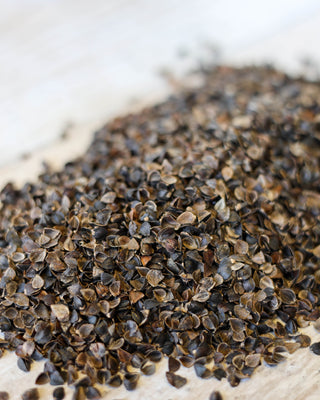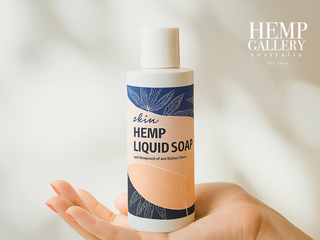Dubai seems to can't get enough of luxury hotels. As if having the world's only seven-star hotel isn't enough, this lavish oasis is set to open a new one, Atlantis the Royal, in 2023.
Reservations have already opened as early as last October as people look forward to spending nights in one of its nearly 800 rooms.
The hotel's most highlighted amenities include a so-called 'mini pillow' menu, which it claims will help people customise their sleep experience. Guests in premium suites and penthouses can choose the type of pillow they desire. Options include cool-down, memory foam head and feet, pregnancy, and buckwheat pillows.
A pillow finding its way to one's home is one thing, but finding its way into a luxurious hotel is another. A hotel probably wouldn't offer such an option if there isn't enough demand. But what makes buckwheat pillows loved by many, if not all? Are its purported benefits all they claim to be?
Let this in-depth review set the record straight.
Buckwheat? Sounds hard
If your first impression of a buckwheat pillow is being too rigid for a pillow, you aren't entirely mistaken. Buckwheat pillows are a far cry from the soft, fluffy headrests that have embodied the stereotypical good night's sleep for ages.
Inside a buckwheat pillow, like the Australian made Buckwheat Hull Pillow and other brands, are thousands, if not millions, of tiny buckwheat hulls.
Instead of throwing them away after having harvested the grain, these hard shells are stuffed inside the casing. The industry normally pegs the weight of a standard buckwheat pillow at between three and four kilos.
The result is a pillow that appears to have returned to its roots millennia ago. Back then, ancient civilisations rested their heads on solid rock, wood, or ceramics, which probably wasn't comfortable, but it was the best they could come up with. At least, they didn't have to sleep on their arms or each other's backs or sides, which was the case in prehistoric times.
But as firm as buckwheat pillows are, they're by no means rock-hard. The individual hulls move around with every twist and turn of the head or body, allowing the pillow to accommodate their weight and posture. In a way, they offer the best of both worlds; the firmness of ancient pillows and the flexibility of modern ones.
The good
According to an article on Medical News Today, a cup of cooked buckwheat groats contains an estimated 5.68 grams of protein, 4.5 grams of fibre, and various vitamins and minerals. Sadly, the same can't be said for the hulls from whence they came because they're too hard to be food.
That doesn't mean they can't help promote good health. Sleep is increasingly becoming a rare commodity in many countries, including Australia, where a survey last year showed that a third of Aussies aren't getting enough sleep. Buckwheat pillows can help with that, as explained by the following advantages.
1. Ideal for managing back pain
Health Direct reports that at least one in six Aussies suffers from back problems, of which 90 per cent of cases aren't attributable to a specific health condition. Most cases don't last several weeks, but others persist for a long time, undermining a person's quality of life.
Can buckwheat pillows help with back pain? One study by researchers at Poland's Wroclaw University of Environmental and Life Sciences suggests that to be the case. A survey of 60 participants, some of whom with skeletal problems, showed that at least half said they had a good sleep on a mattress filled with buckwheat husks.
As for the mattress's hardness, the study mentioned that 80 per cent of participants found it to be 'moderately hard,' while the rest found it to be either normal or hard. Yet, many believed it was a small price to pay for the massage sensation the husks provide as they move around.
These findings, published last year, concurred with previous research, particularly those from a 2019 study of 30 elderly patients in South Korea. Its authors found buckwheat pillows were more effective in reducing neck and shoulder pain than latex ones.
That being the case, it's worth noting that the sample sizes are too small to be acceptable. A large-scale study has yet to be performed at the time of this publication. Nevertheless, these pillows show some promise in managing one of the world's most common health issues.
2. Great for people with allergies
While pillows have gotten softer and cosier over the centuries, they also spurred a new issue: allergies.
Soft fillings like down feathers and latex later began exacting their allergic tolls on people, resulting in effects like asthma and other respiratory problems.
Down feathers are notorious for this for two reasons. One is that they're known to trigger an allergic reaction called feather duvet lung. According to a study of a 43-year-old Scottish man published in the British Medical Journal, he started feeling terribly exhausted after only a few minutes of walking. Doctors suspect his down feather pillows induced this reaction.
Even if you aren't allergic to down feathers themselves, the dust mites they can capture and accumulate over time are another risk. They're also a problem for other types like microfibre and polyester.
Additionally, previous studies showed that extra covers and casings do little to mitigate exposure to dust mites.
It should be noted that buckwheat pillows aren't as hypoallergenic as often advertised, because buckwheat allergy is a thing.
However, a study last year by medical scientists at Sweden's Uppsala University cited that buckwheat pillow allergies are rarer than allergies caused by buckwheat grain, which are still pretty rare.
3. Holds their own under any weight
In many situations, the culprit for chronic body pain is poor sleep posture. The jury is still out on the best sleeping position, as each has pros and cons. For example, experts say sleeping on your back is bad if you snore a lot.
Regardless of whatever position you're comfortable with every night, buckwheat pillows are firm enough to support your body weight.
Follow these tips for making the most of buckwheat pillows in various sleeping positions:
- For side sleeping, have two pillows: one for the head and the other between your knees. Experts say the knee pillow can prevent the local joints from collapsing.
- For back sleeping, have three pillows: one for the head, one for the lower back, and one below the knees. They can reduce the strain on the spine.
- For stomach sleeping, get an additional pillow to place under the pelvis. Make it flat enough by removing some of the buckwheat hulls (and storing them in a jar).
The best sleeping position ultimately comes down to personal preference. However, experts advise against making the pillow too firm, as it can hurt the neck and back as much as one that's too soft.
4. Environmentally (and vegan) friendly
The common buckwheat (Fagopyrum esculentum) is one of the hardiest plants on the planet. They thrive in the highlands of Tibet and southern China, notably the provinces of Sichuan and Yunnan.
Over the centuries, they've been introduced to a large part of the world, even in less cold environments.
Farmers plant buckwheat as a cover crop due to its innate ability to control weed growth and resist most pest infestations. As a result, they rarely - if at all - ever need to spray pesticides, greatly lowering the chance of health risks.
Furthermore, processing the hulls is typically as simple as air-cleaning and air-drying them; no chemical treatments whatsoever.
Buckwheat pillows are also an alternative for vegans and the environmentally conscious.
Down feather pillows are derived from the feathers closest to a duck or goose's skin around the chest and belly, so they're already a hard pass for Australia's growing vegan community.
The bad
Having explained their widely touted benefits, it shouldn't be surprising that buckwheat pillows won't be everyone's cup of tea.
In an era where people have believed pillows to be soft since time immemorial, convincing them that firm ones are just as helpful won't be easy. Plus, it's worth noting that these pillows won't suit some people.
1. Takes a bit of getting used to
If you're buying a buckwheat pillow for the first time, expect some discomfort for several nights as your body adjusts to it. It pays to think that buckwheat pillows aren't your usual bedside companions.
One major inconvenience is the rustling noise the individual shells make every time you toss and turn on the bed. While some find the sound soothing or not much of an issue, others see it as a problem when trying to sleep. Even manufacturers say these pillows can be noisy, but they get less noisy as the hulls eventually break down over time.
The noise can be problematic for couples, requiring them to sleep in separate rooms for some time, if not forever, known as 'sleep divorce.'
Sleep consultants say they don't think it's bad, given that millions of Aussies struggle to get enough sleep. If sleep divorce results in a clear mind and improved health upon waking up, it's worth it.
Some dissatisfied buyers refer to these pillows as a bag of rocks, though it's inaccurate to say they're inflexible like rocks. As mentioned early in this piece, buckwheat hulls are rigid but at least aren't a single slab like the pillows of antiquity. The hulls will displace with enough twisting and turning applied to them.
2. Heavy for a pillow
Also mentioned earlier, a standard buckwheat pillow weighs between 3 and 4kg. If considering all the sizes available, the weight range grows to between 1.8 and 5.4kg. For comparison, that's about as heavy as an adult domestic cat and slightly heavier than a fresh can of paint.
Most manufacturers estimate the average volume of buckwheat hulls at 200 cubic inches per pound. As such, a standard-size Australian pillow, 51x66cm, with a maximum preferable height of 10cm, should contain at least 34 litres of buckwheat hulls. That figure translates to 3.6 to 4.5kg of buckwheat hulls as filling.
Moreover, that weight exerts undue stress on the casing fabric, hence the need for stronger fabric. Hemp and organic cotton is a good choice because of how the threads are arranged (being a twill results in a higher thread count and increased durability).
3. A pain to wash
You can throw a conventional pillow in a washing machine, even with the filling still inside, but that isn't the case for buckwheat pillows. Exposing the hulls to water is an excellent way to greatly shorten the pillow's lifespan.
People who grow buckwheat in their homes normally soak the seeds in water for eight hours before planting. The water softens the hull, helping the sprout break out. The same applies to the hulls inside the pillows; water will severely degrade their rigidity, making the pillow no firmer than a conventional one.
For the record, washing a buckwheat pillow is possible but is a pain. The first step involves emptying the casing and storing the hulls in a large-enough container. It's crucial to account for every hull, because a missing handful can affect the pillow's height and firmness.
Conclusion
Experiencing resting on a buckwheat pillow doesn't necessarily mean booking a night at a posh hotel.
The market is teeming with such pillows from various brands, all for relatively the same cost as conventional pillows.
A buckwheat pillow can be vital for those who constantly wake up to body pain.
Its firmness and durability translate to restful nights for several years, provided you care for it properly. But for first-time users, a brief adjustment period may be necessary.
Hemp Gallery provides a beautiful Australian grown and made Buckwheat Hull pillow. All the buckwheat hulls are grown in Parkes, NSW and the cotton pillows are made with Australian grown and woven cotton.



